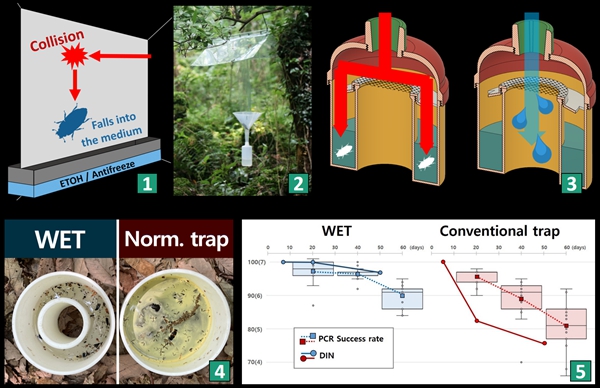Insects, a highly diverse group, have played significant roles in ecosystems. Sampling strategies using passive traps like window, pitfall, and Malaise traps have been pivotal for large-scale studies, such as biodiversity and evolutionary studies. The window trap, efficient for collecting beetles, blocks flight paths, guiding insects into a collector with preservation fluid. However, the trap's major flaw is water intrusion, diluting preservatives and degrading specimens and their DNA. Efforts to improve traps, like adding roofs, have been able to entirely solved this issue, especially in rainy areas. This challenge hinders molecular biomonitoring, crucial for entomology, and DNA-based technologies.
In a study published in Methods in Ecology and Evolution entitled “The Water-Exclusion Trap (WET): A 3D printable window trap collector that prevents DNA degradation” on 18th September 2023, researchers led by Prof. BAI Ming from the Institute of Zoology of the Chinese Academy of Sciences, together with researchers from Seoul National University (South Korea), and Imperial College London (United Kingdom) developed the WET (Water-Exclusion Trap), a 3D-printable long-term storable bottom collector for window traps (Figure 1). The collection medium in WETs are not diluted because water is excluded and evaporation is limited, maximizing DNA preservation.
During operation, rainwater and dewdrops trickles through the mesh, while trapped beetles roam inside and eventually fall into the preserving liquid. This setup basically installs a pitfall mechanism within a window trap, shielding against water dilution and deterring debris intrusion, such as pollen or wood shavings. A wide mesh placed atop the funnel blocks the entry of larger beetles, which are rich in bodily fluids, thus averting further medium dilution.
WET produced significantly higher quality insect samples in comparison to conventional traps, with notable differences even observable to the naked eye. The authors also proved that the Insect samples collected by WETs in the field had significantly higher DNA quality, supported by PCR success rates and DNA Integrity Numbers compared to conventional traps.
The WET addresses a critical challenge encountered by window traps – the degradation of DNA caused by water infiltration. Its applications are far-reaching, including in projects like IOZ's SITE-100 project, which focuses on site-based biodiversity genomics for species discovery, community ecology, and constructing a global tree of life. Particularly in regions with substantial rainfall, such as tropical rainforests, the WET trap gains paramount importance. In such locales, the constant deluge often results in significant DNA deterioration within window traps, impeding the exploration of numerous insects and their yet-to-be-revealed genetic insights and the WET can be a breakthrough.
This work was supported by National Key R&D Program of China founded by the Ministry of Science and Technology of China; the Chinese Academy of Sciences President’s International Fellowship Initiative for Postdoctoral Fellows; grants from Ministry of Science and Technology of China, grants from National Science Foundation of China; This research was also supported by Basic Science Research Program through the National Research Foundation of Korea funded by the Ministry of Education.

Figure. Design and operation of Water-Exclusion Trap (WET). (Image by Bai’s lab)
1. The operating principle of window trap; 2. Conventional window trap with roofs; 3. Design and operation of Water-Exclusion Trap (WET); 4. Samples in collection medium 20 days after installation, left: WET, right: Conventional bottom collector; 5. Success rates of DNA isolation and PCR amplification for Water-Exclusion Trap (WET) and conventional trap, left: WET, right: Conventional trap, numbers in left Vertical axis: PCR success rate, numbers in parentheses: DNA Integrity DIN Numbers. WET had consistently higher PCR success rates and significantly higher DNA Integrity than the conventional trap.
Link: https://besjournals.onlinelibrary.wiley.com/doi/10.1111/2041-210X.14205
Contact:
Ming BAI
Ph.D. Full Professor
Principal Investigator of the Group of Morphology and Evolution of Beetles,Institute of Zoology, Chinese Academy of Sciences
Tel: +86-10-64807928
Email: baim@ioz.ac.cn

